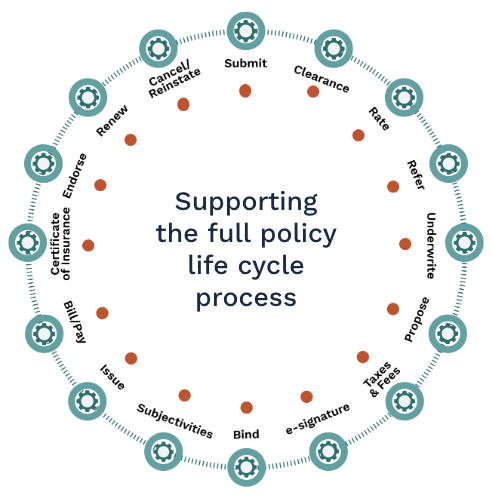A 2018 study by Celent, titled North American Policy Administration Systems 2018, presented a survey of policy admin system customer satisfaction ratings. There were six criteria rated on a scale of 1 to 5: support, integration, technology, functionality, implementation, and configurability.
We looked at the individual ratings and calculated an average customer rating across all 20+ vendors for each category. Customer satisfaction was highest with support, configurability, integration, and technological capabilities, but lacking in functionality and implementation.
This article will contrast industry standards for each of these categories with a microservices-based policy administration system and give some tips for insurance professionals on what they should expect from policy admin vendors when pursuing P&C insurance digital transformation.
Functionality of Policy Administration Systems
Insurance policy administration systems (PAS) are responsible for managing the entire insurance policy life cycle (ie. rate, quote, issue, endorse, renew). According to Celent’s perspective, it is the “primary system of record for property and casualty, general, and specialty insurance business operations, handling all transactions from the front end of individual policyholder management to the back end of billing and premium payments.”
For reference, Figure 5 (right) is a diagram presented in the research that documents the wide range of functionality at least partially covered by most existing PAS solutions in the marketplace today. Suite functionality varies from vendor to vendor; Company A’s platform might include reinsurance capabilities while Company B focuses mainly on primary policy administration.

Functionality-Related Procurement Tips
- Document your specific functionality needs and match them to each vendor's offerings.
- Establish which business objectives are the highest priority and determine which PAS functionalities will help you achieve them.
- Improve flexibility and agility by choosing a PAS with microservice-based architecture.
Keep in mind, technology is improving at a rapid pace. Most available policy administration systems today are built on outdated monolithic architecture. These systems are tightly coupled, complex, difficult to extend and customize, and expensive to maintain.
We suggest looking for a policy administration platform that is built from the ground up on a microservice-based architecture. Microservices remove the constraints of traditional, monolithic systems and align you with the changing tide of how insurance will be sold and managed in the future.
Implementing Policy Administration Systems
Product Implementation, across the 20 policy administration vendors, ranked fifth out of six on a scale of satisfaction from one to five. This means insurers are frustrated by the competencies of implementation teams rolling out PAS solutions. Many insurers have had the experience of hearing promises that aren’t kept in terms of launch dates, not getting transparency around the features and functionality being delivered, or a lack of communication.
The successful implementation of complex software like as core insurance systems requires a marriage of both a solid architectural platform and the right people at the helm. It isn’t enough for a vendor to have a great development team with an outdated technology platform or vice versa.
Implementation-Related Procurement Tips
- Assess the vendor's product, onboarding processes, and communication styles.
- Evaluate the skill sets and experience of the implementation team.
- Strive for transparency of goals and deliverables during the sales process and beyond.
When evaluating the strengths and weaknesses of a policy administration vendor’s implementation processes, focus on their communication practices and the skill sets of team members assigned to your project. We emphasize complete transparency, not just during implementation, but from the moment that sales conversations begin. Your first touchpoint should be built on honesty, respect, expectation, and alignment.
During the sales process, look for sandboxes that allow you to assess the technology on your own. Conduct deep dive meetings on functionality, architecture, and onboarding processes. Take the time to have detailed scoping workshops to ensure both teams are aligned and proper expectations have been set on all project fronts. These activities set the foundation for a strong relationship and a smooth implementation process.
These core principles extend past the sales process and into project implementation. We use an agile, iterative implementation approach, with an emphasis on incorporating third-party content where it’s appropriate. Our focus in every partnership is the rapid delivery of business value, continuous improvement, high-quality deliverables, and project transparency and visibility. These translate not only into optimal implementation timelines but also into a technology platform and partner that is aligned to your goals and requirements.
Get Started With Solartis
Start the evaluation process with Solartis by contacting one of our knowledgeable team members. Explore our unique approach to policy administration solutions using a modern microservice-based architecture and learn about how we use an agile implementation methodology combined with available and proven third-party content to expedite the onboarding process and reduce project risks.
"They are fast, simple, and cost-effective. Their team is an extremely reasonable group of people who care, really care, about your success. Every launch has some bumps - they worked above and beyond to make sure those bumps didn't disrupt our launch or our ability to write new business. Without Solartis, I wouldn't be projecting a 30% increase in topline growth."
said Cameron Linder, CEO, Western Bowling Proprietors Insurance (WBPI), Rednil Insurance Brokers, Inc.





